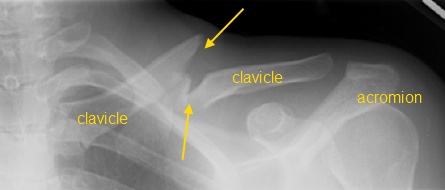Shoulder Case 7 History/Physical Exam
Clavicle Fracture
History and Physical Exam
 Young adults often have high mechanism injuries such as motor vehicle collisions, contact sports, or biking injuries. Older adults can fracture from low mechanism falls. Patients typically hold the arm adducted. There is tenderness to direct palpation and often swelling and crepitance over the fracture. Shoulder range of motion is typically decreased secondary to pain. Occasionally tenting and step-offs can be appreciated on palpation. Perform a neurovascular exam, checking for brachial plexus and subclavian vessel injury.
Young adults often have high mechanism injuries such as motor vehicle collisions, contact sports, or biking injuries. Older adults can fracture from low mechanism falls. Patients typically hold the arm adducted. There is tenderness to direct palpation and often swelling and crepitance over the fracture. Shoulder range of motion is typically decreased secondary to pain. Occasionally tenting and step-offs can be appreciated on palpation. Perform a neurovascular exam, checking for brachial plexus and subclavian vessel injury.